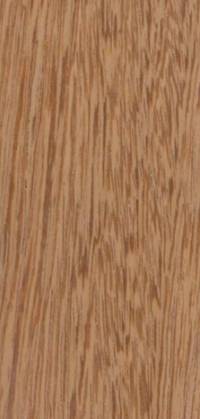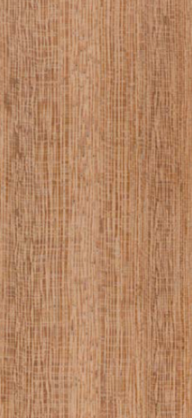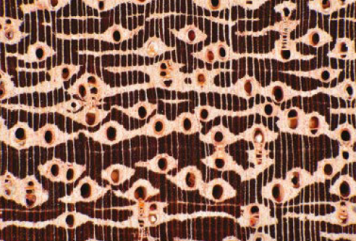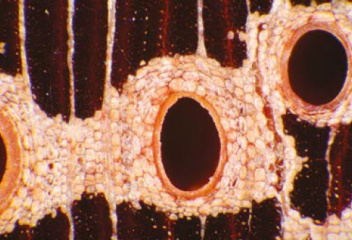Angelim
| Family | Leguminosae (Fabaceae) |
| Botanical Names | Hymenolobium excelsum |
| Continent | Latin America |
| CITES | (Washington convention of 2017)
No trade Restrictions |
| Diameter | 70 – 120 cm |
| Thickness of Sapwood | 3 – 5 cm |
| Buoyancy | Does not float |
| Log Conservation | Moderate (Treatment recommended) |
Wood Description
| Reference colour | Sapwood | Texture | Grain | Interlocked grain | Notes |
|---|---|---|---|---|---|
| orange yellow | Not clearly demarcated | Coarse | Interlocked grain | slight | yellow brown becoming pinkish Brown on exposure. Fairly important waxen patches frequent. |
Flat Sawn

Quarter Sawn

Physical and Mechanical properties
| Property | Mean Value |
|---|---|
| Density* | 0.80 |
| Monnin hardness* | 6.3 |
| Coefficient of volumetric shrinkage | 0.67% per % |
| Total tangential shrinkage (Ts) | 8.3% |
| Total Radial shrinkage (Rs) | 4.9% |
| T/R anisotropy ratio | 1.7 |
| Fibre Saturation point | 25% |
| Thermal conductivity | 0.26 W/(m.K.) |
| Lower heating value | 19,050 kJ/kg |
| Crushing strength* | 67 MPa |
| Static bending strength* | 119 MPa |
| Longitudinal modulus elasticity* | 20,870 MPa |
Natural durability & Treatability
| Resistance to decay | Class 3 - moderately durable |
| Resistance to dry wood borers | Class S – Susceptible (risk in all the wood) |
| Resistance to termites | Class S – Susceptible |
| Treatability | Class 2 – Moderately permeable |
| Use class covered by natural durability | Class 2 - inside or under cover (dampness possible) |
Notes
Resistance to decay moderate to good according to the species
Preservation Treatment
| Against dry wood borer attacks. | This wood requires appropriate preservative treatment. |
| In case of temporary humidification | This wood requires appropriate preservative treatment. |
| In case of permanent humidification | Use of this wood is not recommended. |
Sawing and Machining
| Blunting effect | Normal |
| Tooth for sawing | ordinary or alloy steel |
| Machining tools | Ordinary |
| Suitability for peeling | Bad |
| Suitability for slicing | good |
| Notes | Possible sawing and machining difficulties if the waxen patches are numerous. These patches remain visible after machining. |
Drying
| Drying rate | rapid to norma |
| Risk of distortion | Slight risk |
| Risk of case hardening | No known specific risk |
| Risk of checking | Slight risk |
| Risk of collapse | No known specific risk |
| Suggested drying schedule | Schedule # 6 |
Assembling
| Nailing/ Screwing | Good but pre – boring necessary. |
| Notes | Tends to end checks when nailing. High specific gravity: important that gluing be performed in compliance with the code of practice and instructions for the glue used. |
Cross sections of Buchenavia fanshawei


Commercial Grading
Sawn timber appearance grading
According to NHLA grading rules (2015) Possible grading: FAS, Select, Common 1, Common 2, Common 3 In French Guiana, the local name of this species is "Saint Martin Jaune". Grading is done according to local rules "Bois guyanais classes (1990)". Possible grading: Choice 1, choice 2, choice 3, choice 4
Fire Safety
| Conventional French grading | Thickness > 14 mm: M3 (moderately inflammable)
Thickness < 14 mm: M4 (easily inflammable) |
| Euroclass grading | D-s2, d0
Default grading for solid wood that meets requirements of European standard NF EN 14081-1 (April 2016): structural graded timber in vertical uses and ceilings with minimal mean density of 0.35 and minimal thickness of 22 mm. |
Visual structure grading
According to French standard NF B 52-001-1 (2011), strength class D40 can be provided by visual grading.
Main End uses
- Interior joinery
- Exterior joinery
- Current furniture or furniture components
- Stairs (inside)
- Industrial or heavy flooring
- Sliced veneer
- Interior panelling
- Exterior panelling
- Moulding
- Heavy carpentry
- Flooring
Notes
Extensive sanding is needed to obtain a good finish.